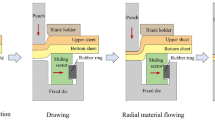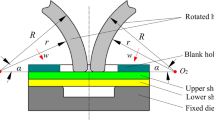Abstract
Mechanical clinching technology has been widely used to join aluminum alloy sheets in the automotive body. One of the disadvantages of the clinched joint is the high protrusion above the sheet, which may limit the application of the mechanical clinching technology in the visible areas. In order to reduce the height of the protrusion, two compressing methods were investigated with dissimilar aluminum alloy sheets in this paper. Both the two compressing methods can increase the strength of the joint. The height of the protrusion was reduced significantly in the compressing process. The absorption capability of the energy in the failure process was also increased by the two compressing methods. The compressing method with a flat die and a bumped die has a better performance than the compressed joint produced by a pair of flat dies. Neck fracture mode is the main joint failure mode in the strength test. The strength of the joint can be increased with the compressing methods by increasing the neck thickness in the compressing processes.
Similar content being viewed by others
References
Lambiase F (2015) Clinch joining of heat-treatable aluminum AA6082-T6 alloy under warm conditions. J Mater Process Technol 225:421–432
Lambiase F (2015) Joinability of different thermoplastic polymers with aluminium AA6082 sheets by mechanical clinching. Int J Adv Manuf Technol 80(9):1995–2006
He XC (2010) Recent development in finite element analysis of clinched joints. Int J Adv Manuf Technol 48(5):607–612
Lambiase F, Di Ilio A, Paotetti A (2015) Joining aluminium alloys with reduced ductility by mechanical clinching. Int J Adv Manuf Technol 77(5):1295–1304
Jiang T, Liu ZX, Wang PC (2015) Quality inspection of clinched joint of steel and aluminum. Int J Adv Manuf Technol 76(5):1393–1402
Chen C, Zhao SD, Han XL, Cui MC, Fan SQ (2017) Investigation of the height-reducing method for clinched joint with AL5052 and AL6061. Int J Adv Manuf Technol 89(5):2269–2276
Lee CJ, Kim JY, Lee SK, Ko DC, Kim BM (2010) Parametric study on mechanical clinching process for joining aluminum alloy and high-strength steel sheets. J Mech Sci Technol 24:123–126
Mucha J, Kaščák L, Spišák E (2013) The experimental analysis of forming and strength of clinch riveting sheet metal joint made of different materials. Adv Mech Eng 5:1–11
He XC, Gu FS, Ball A (2014) A review of numerical analysis of friction stir welding. Prog Mater Sci 65:1–66
He XC (2017) Clinching for sheet materials. Sci Technol Adv Mat. doi:10.1080/14686996.2017.1320930
Zhang Y, He XC, Zeng K, Lei L, Gu FS, Ball A (2017) Influence of heat treatment on mechanical properties of clinched joints in titanium alloy sheets. Int J Adv Manuf Technol. doi:10.1007/s00170-017-0019-5
He XC (2011) A review of finite element analysis of adhesively bonded joints. Int J Adhes Adhes 31(4):248–264
Mucha J, Kaščák L, Spišák E (2011) Joining the car-body sheets using clinching process with various thickness and mechanical property arrangements. Arch Civ Mech Eng 11(1):135–148
Chen C, Zhao SD, Cui MC, Han XL, Fan SQ (2016) Mechanical properties of the two-steps clinched joint with a clinch-rivet. J Mater Process Technol 237:361–370
Mori K, Maeno T, Fuzisaka S (2012) Punching of ultra-high strength steel sheets using local resistance heating of shearing zone. J Mater Process Technol 212:534–540
Chen C, Zhao SD, Cui MC, Han XL, Fan SQ (2017) Numerical and experimental investigations of the reshaped joints with and without a rivet. Int J Adv Manuf Technol 88(5):2039–2051
Mucha J, Witkowski W (2014) The clinching joints strength analysis in the aspects of changes in the forming technology and load conditions. Thin-Walled Struct 82:55–66
Varis J (2006) Ensuring the integrity in clinching process. J Mater Process Technol 174:277–285
Xu F, Zhao SD, Cai J, Han XL (2014) The experimental analysis of shear strength of round joints. Proc IMechE Part B: J Engineering Manufacture 228:1280–1289
Chen C, Zhao SD, Han XL, Cui MC, Zhao XZ, Ishida T (2017) Experimental investigation of the mechanical reshaping process for joining aluminum alloy sheets with different thicknesses. J Manuf Process 26:105–112
He XC, Zhang Y, Xing BY, Gu FS, Ball A (2015) Mechanical properties of extensible die clinched joints. Mater Des 71:26–35
Chen C, Zhao SD, Cui MC, Han XL, Fan SQ, Zhao XZ (2017) Comparative investigation of auxiliary processes for increasing the strength of clinched joints. Proc IMechE Part E: J Process Mechanical Engineering. doi:10.1177/0954408916686998
Lambiase F, Di Ilio A (2016) Damage analysis in mechanical clinching: experimental and numerical study. J Mater Process Technol 230:109–120
Lambiase F, Di Ilio A (2014) An experimental study on mechanical clinched joints realized with different dies. Thin-Walled Struct 85:71–80
Mucha J, Witkowski W (2013) The experimental analysis of the double joint type change effect on the joint destruction process in uniaxial shearing test. Thin-Walled Struct 66:39–49
Varis J (2006) Economics of clinched joint compared to riveted joint and example of applying calculations to a volume product. J Mater Process Technol 172:130–138
Chen C, Zhao SD, Han XL, Cui MC, Fan SQ (2016) Investigation of mechanical behavior of the reshaped joints realized with different reshaping forces. Thin-Walled Struct 107:266–273
Lee CJ, Kim JY, Lee SK, Ko DC, Kim BM (2010) Design of mechanical clinching tools for joining of aluminium alloy sheets. Mater Des 31:1854–1861
Abe Y, Mori K, Kato T (2012) Joining of high strength steel and aluminium alloy sheets by mechanical clinching with dies for control of metal flow. J Mater Process Technol 212(4):884–889
Mucha J (2011) The analysis of lock forming mechanism in the clinching joint. Mater Des 32:4943–4954
Oudjene M, Ben-Ayed L, Delamézière A, Batoz JL (2009) Shape optimization of clinching tools using the response surface methodology with moving least-square approximation. J Mater Process Technol 209:289–296
Chen C, Zhao SD, Cui MC, Han XL, Fan SQ, Ishida T (2016) An experimental study on the compressing process for joining Al6061 sheets. Thin-Walled Struct 108:56–63
He XC, Zhao L, Yang HY, Xing BY, Wang YQ, Deng CJ, Gu FS, Ball A (2014) Investigations of strength and energy absorption of mechanical clinched joints. Comput Mater Sci 94:58–65
Xing BY, He XC, Wang YQ, Yang HY, Deng CJ (2015) Study of mechanical properties for copper alloy H62 sheets joined by self-piercing riveting and clinching. J Mater Process Technol 216:28–36
Eshtayeh M, Hrairi M, Mohiuddin AKM (2016) Clinching process for joining dissimilar materials: state of the art. Int J Adv Manuf Technol 82(1):179–195
Jiang T, Liu ZX, Wang PC (2015) Effect of aluminum pre-straining on strength of clinched galvanized SAE1004 steel-to-AA6111-T4 aluminum. J Mater Process Technol 215:193–204
Lambiase F, Di Ilio A (2015) Mechanical clinching of metal–polymer joints. J Mater Process Technol 215:12–19
Lambiase F, Durante M, Di Ilio A (2016) Fast joining of aluminum sheets with glass fiber reinforced polymer (GFRP) by mechanical clinching. J Mater Process Technol 236:241–251
Lambiase F (2015) Mechanical behaviour of polymer–metal hybrid joints produced by clinching using different tools. Mater Des 87(15):606–618
Lambiase F, Ko D-C (2016) Feasibility of mechanical clinching for joining aluminum AA6082-T6 and carbon fiber reinforced polymer sheets. Mater Des 107:341–352
Zhao SD, Xu F, Guo JH, Han XL (2014) Experimental and numerical research for the failure behaviour of the clinched joint using modified Rousselier model. J Mater Process Technol 214:2134–2145
Chen C, Fan SQ, Han XL, Zhao SD, Cui MC, Ishida T (2016) Experimental study on the height-reduced joints to increase the cross-tensile strength. Int J Adv Manuf Technol. doi:10.1007/s00170-016-9939-8
Chen C, Zhao SD, Cui MC, Han XL, Zhao XZ, Ishida T (2016) Effects of geometrical parameters on the strength and energy absorption of the height-reduced joint. Int J Adv Manuf Technol. doi:10.1007/s00170-016-9619-8
Neugebauer R, Mauermann R, Dietrich S, Kraus C (2007) A new technology for the joining by forming of magnesium alloys. Prod Eng-Res Dev 1:65–70
Gerstmann T, Awiszus B (2014) Recent development in flat-clinching. Comput Mater Sci 81:39–40
Chen C, Zhao SD, Han XL, Cui MC, Fan SQ (2016) Optimization of a reshaping rivet to reduce the protrusion height and increase the strength of clinched joints. J Mater Process Technol 234:1–9
Wen T, Wang H, Yang C, Liu LT (2014) On a reshaping method of mechanical clinched joints to reduce the protrusion height. Int J Adv Manuf Technol 71:1709–1715
He XC, Liu FL, Xing BY, Yang HY, Wang YQ, Deng CJ, Gu FS, Ball A (2014) Numerical and experimental investigations of extensible die clinching. Int J Adv Manuf Technol 74:1229–1236
Author information
Authors and Affiliations
Corresponding author
Rights and permissions
About this article
Cite this article
Chen, C., Han, X., Zhao, S. et al. Comparative study on two compressing methods of clinched joints with dissimilar aluminum alloy sheets. Int J Adv Manuf Technol 93, 1929–1937 (2017). https://doi.org/10.1007/s00170-017-0650-1
Received:
Accepted:
Published:
Issue Date:
DOI: https://doi.org/10.1007/s00170-017-0650-1




